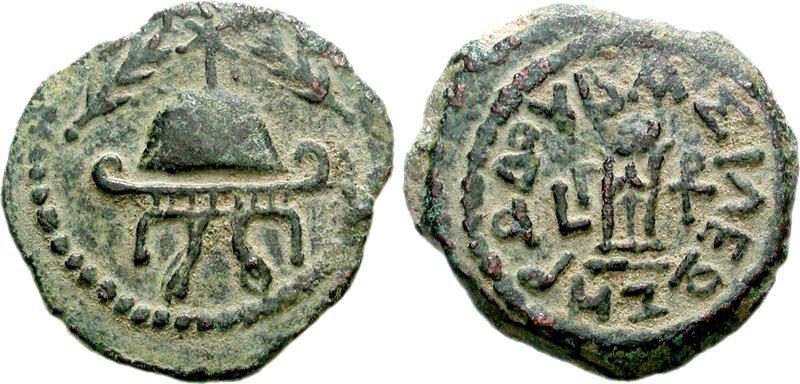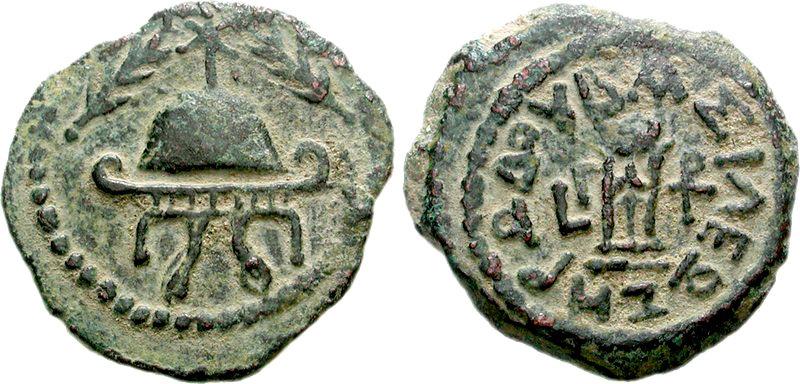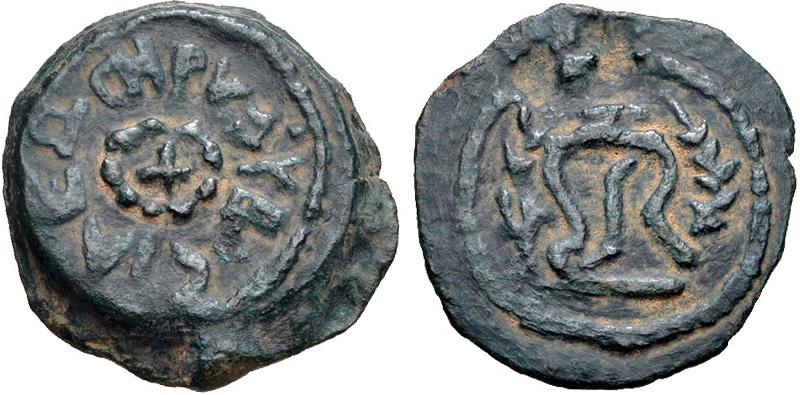King Herod a Messiah?
King Herod a Messiah?
Everyone agrees that at some point the staurogram became an early symbol of Christianity. It combines the Greek letter “Tau”, which is shaped like a “T” and the Greek letter “Rho”, which is shaped like a “P”. Put them together and you’ve got an image that came to mean Jesus on the cross. But, recently, Professor Larry Hurtado wrote an article for Biblical Archaeology Review which pointed out pre-Christian uses of the staurogram e.g., on a coin that King Herod used in the year 37 BCE i.e., some 60 years before Jesus’ crucifixion. So the question is; was the staurogram a non-messianic symbol that Christians turned into a messianic symbol? Or was the staurogram a messianic symbol before Jesus, and Christians merely adapted it for their messiah?
In the short article below, my friend David Wray, author of the excellent “The Secret Roots of Christianity: Decoding Religious History with Symbols on Ancient Coins”, suggests that the staurogram, the cross and even the “Chi” for “Christos” i.e., the “Christ”, were on King Herod’s coin some 40 years before the birth of Jesus of Nazareth because they were the symbolic currency that a king used to claim to be the anointed one i.e., the “Christ”.
Put simply, it seems that King Herod claimed to be the messiah or “Christ” before Jesus was born and, according to the 1st century historian Josephus, King Herod’s grandson, Herod Agrippa, was hailed as a “messiah” after Jesus was crucified. It’s logical, therefore, to assume that King Herod’s son, Herod Antipas, also thought of himself as a messiah or “Christ”. This would go a long way to explain why Antipas turned Jesus over to the Romans, who sent him to the cross. It seems that the clash between Jesus and Antipas was not one between a revolutionary and the regime. Rather, what the Gospels are describing is a clash between two individuals – both claiming to be messiah.
Why was a staurogram (¬ ), a symbol that combines a tau (T) and a rho (P) representing the crucifixion of Jesus, displayed prominently on a coin minted in Samaria under King Herod the Great of Judaea?
New Testament scholar, Professor Larry Hurtado, recently wrote an article about staurograms using this coin to exemplify pre-Christian, non-messianic use of the symbol. He said that King Herod used the symbol in 37 B.C.E. to represent the Greek word “trias,” meaning three, indicating the third year of King Herod’s reign. However, numismatists (experts on coins) don’t all agree with Professor Hurtado’s interpretation.
You see, he ignored all the other symbols on the coin. On the “heads” side (left) a star rises above a military helmet as though at the end of a scepter. This recalls Balaam’s curse (Numbers 24:17), the original prophecy from the time of Moses about the coming of a messiah, “I shall see him, but not now: I shall behold him, but not nigh: there shall come a Star out of Jacob, and a Sceptre shall rise out of Israel, and shall smite the corners of Moab, and destroy all the children of Sheth.” Palm branches next to the star recall that palm branches, symbols of rejoicing and triumph, were strewn on the path before Jesus on Palm Sunday. No Jew in the first century B.C.E could look at these symbols without thinking of their foretold militaristic messiah.
The number three appears on the “tails” side of the coin, but that’s only part of the story. Greek letters circle the edge of the coin saying “of King Herod.” An incense altar in the center recalls incense burning in the Second Temple. To the left of the burner, the Greek letters L and Γ are a date, literally “year three” of King Herod’s reign. Instead of indicating “three,” the staurogram to the right of the burner actually combines a chi (X) and a rho (P), representing “christos,” the Greek word for “anointed.” In Hebrew, that’s moshiach (messiah)!
How could this be possible?
In 40 B.C.E., the Parthians and Romans each anointed a “King of the Jews” and fought a war to determine which puppet would rule Judaea. The Parthians anointed Mattathias Antigonos and the Romans anointed Herod. After three years, the Romans won and installed King Herod on his throne. As the first Jewish king to use only Greek on his coins, he combined a chi and rho on his coins to symbolize himself as the rightfully anointed (christos) King of Judaea.
King Herod used similar symbols even more explicitly on a coin minted in Jerusalem.On the “heads” side, Greek letters circle a royal crown and a chi (X) in the center, again saying “of King Herod.” Resembling a Christian cross, the chi stands for “christos.” On the “tails” side, palm branches again flank an incense altar. To Jews, King Herod made symbolic claims that he was their foretold messiah.
Is there any historical evidence for interpreting these coins as claims by King Herod that he was the messiah? Yes! A text from the third century C.E. describes a Jewish cult that honored King Herod as their messiah. The cult was founded by Boethus, High Priest of the Second Temple under King Herod.
By using a Jewish coin to exemplify the non-messianic use of a staurogram, Professor Hurtado opens a window to pre-Christian Jewish messianism. However, the theory that Christians invented the messianic symbolism of staurograms in approximately 150 C.E. simply doesn’t hold water.
Coin Images were provided by the Classical Numismatic Group, Inc. You can find these and many other beautiful images of ancient coins at www.cngcoins.com



